Containers for Water Gardens: A Complete Guide
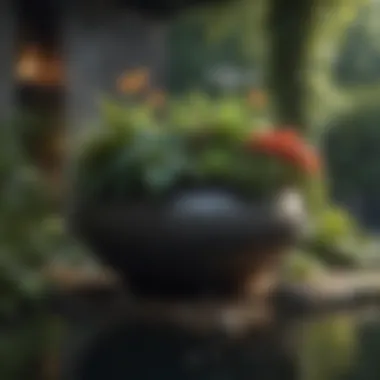
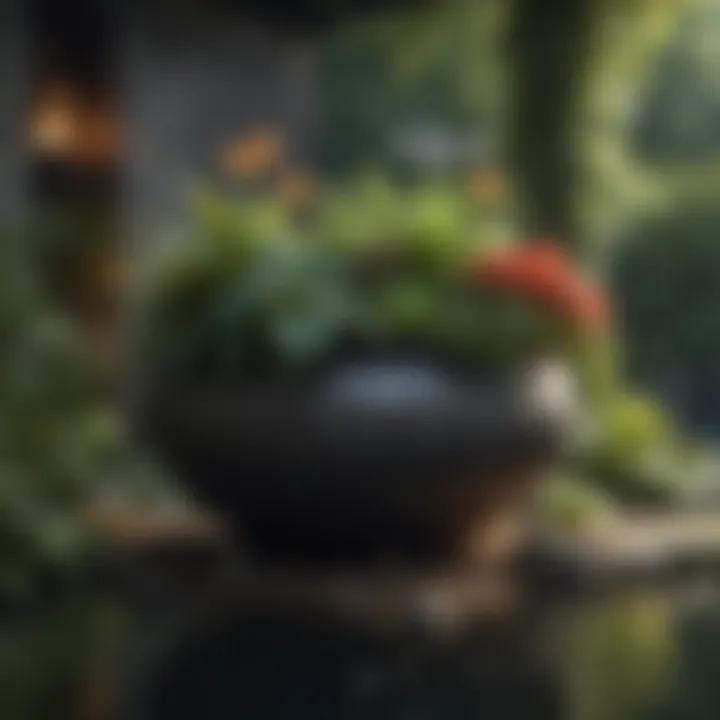
Intro
Creating a water garden is like crafting a living masterpiece, where each container plays a vital role in nurturing aquatic life and contributing to the overall aesthetic. The right containers not only enhance the visual appeal of the garden but also serve specific functions essential for the plants and creatures living within. As homeowners and gardening enthusiasts delve into this captivating world, they must consider various factors such as materials, shapes, and sizes of containers.
Determining which containers will mesh well with the garden’s design, while fostering a healthy aquatic ecosystem, is no small task. This guide aims to walk you through every aspect of this journey—whether you’re just dipping your toes in or are ready to dive deep into the art of water gardening.
Container Considerations
When selecting a container for your water garden, several factors come into play. First and foremost is the material of the container. Some common choices include:
- Ceramic: Offers a classic look and is generally frost-resistant, but can crack in extreme conditions.
- Plastic: Lightweight and durable; however, it's wise to choose UV-resistant options to avoid brittleness over time.
- Metal: While stylish, it can heat up quickly and may not be suitable for all aquatic plants.
- Fiberglass: Combines durability and design, often mimicking natural stone or other materials.
Additionally, you'll want to consider size and depth. Deep containers can support a wider variety of aquatic plants, while shallow ones may suit smaller, more delicate species. A balance between dimensions and visual harmony in your garden layout is crucial. Some other essentials include ensuring that the container has drainage holes to prevent roots from becoming waterlogged and promoting healthy growth.
"The right container isn’t just a pot; it’s a sanctuary for aquatic life."
Plants Play a Key Role
Choosing the right plants to pair with your containers is equally important. Different plants have varying water needs, growth habits, and sun requirements. Here’s a brief rundown of what to consider:
- Submerged plants (like Anacharis): These live underwater and improve water quality by absorbing nutrients.
- Floating plants (such as Water Hyacinth): They sit on the surface and provide shade, helping keep the water cool.
- Marginal plants (like Cattails): These grow at the edges of the water, providing stability and visual interest.
Successful pairing creates not only a vibrant look but a balanced ecosystem that supports fish and other wildlife.
Placement and Aesthetics
Strategically placing your containers can transform an ordinary area into an alluring oasis. Consider the sun's path, ensuring your plants get the right amount of light without being scorched.
In terms of aesthetics, here are a few pointers:
- Vary heights: Use taller containers in the back and lower ones in the front to create depth.
- Group similar colors: It creates a cohesive look and draws the eye to particular spaces.
- Determine focal points: A standout container can serve as an anchor for the design, while others complement it quietly.
Fostering a harmonious environment helps maintain plant health, enhances biodiversity, and draws nature closer to your living space.
End
In the end, selecting containers for your water garden is an engaging exploration of beauty and functionality. With the right wisdom and a touch of creativity, you can create an ecosystem that not only pleases the eye but supports a thriving habitat for diverse aquatic life. By thoughtfully considering materials, sizes, plant compatibility, and aesthetic arrangement, emerging water garden enthusiasts can truly make a splash in their backyard.
Understanding Water Gardens
Water gardens have emerged as a popular trend among gardening enthusiasts, functioning not only as aesthetic enhancements but also as sustainable ecosystems. They combine the charm of natural scenery with the delicate balance of aquatic life, creating spots of tranquility in often bustling environments. Understanding water gardens involves digging deeper into their purpose, types, and how they can integrate within your overall landscape design.
Definition and Purpose
A water garden, at its core, is a landscaped area that primarily features water as a central element. Usually, it includes various aquatic plants, fish, and other elements like rocks or sculptures that harmonize with the water feature. These gardens serve multiple purposes. Firstly, they contribute to biodiversity by providing a habitat for various wildlife, including frogs, dragonflies, and birds. Secondly, they can enhance the visual appeal of a yard or garden, turning it into a stunning focal point. In addition to that, water gardens can also improve a property’s value, offering a unique element that draws potential buyers.
Types of Water Gardens
Water gardens primarily fall into two categories: naturalistic water gardens and formal water gardens. Each type possesses distinct characteristics and offers unique benefits.
Naturalistic Water Gardens
Naturalistic water gardens embody the aesthetics of nature itself. They usually imitate natural ecosystems, featuring irregular shapes and native plants. Key features include the use of rocks, varying depths, and organically shaped ponds. The main advantage of this style lies in its eco-friendliness; by promoting native species, these gardens can support local wildlife and contribute to environmental balance. Additionally, they require less maintenance in the long run, as the natural filtration process often keeps water quality high. The biggest challenge, however, lies in the initial setup, which might necessitate extensive ground work and planning to achieve that perfect natural look.
Formal Water Gardens
In contrast, formal water gardens follow a structured, symmetrical design. Often characterized by clean lines, geometric shapes, and well-defined edges, these gardens focus on formality and elegance. A hallmark feature is the use of containers and fountains, which add movement and sound to the tranquility of the water. These designs lend themselves well to modern landscaping, providing a chic visual element that can elevate any environment. While they can be visually stunning, formal water gardens tend to demand more regular maintenance and can potentially disrupt local ecosystems due to their highly manipulated environments.
"Whether leaning toward naturalistic or formal designs, the essence of a water garden is the integration of water features into the broader landscape. This not only enhances beauty but also fosters a rich habitat for diverse life forms."
Understanding these types of water gardens is vital for homeowners and garden enthusiasts alike, as selecting the right type can significantly impact both appearance and ecological outcomes.
Significance of Containers
Water gardens are not just a splash of color in a backyard; they encompass a beauty and serenity that captivates many gardeners. Within this charming landscape, the containers you select play a critical role. They serve multiple purposes, acting as both a functional and aesthetic component of the ecosystem. In this section, we'll explore the significance of containers in water gardening, delving deeper into their roles in ecosystem management and aesthetic contributions.
Role in Ecosystem Management
Containers are pivotal in managing an aquatic garden's delicate ecosystem. They act as habitats for various aquatic life forms and plants, effectively fostering a mini-ecosystem that can thrive with proper care.
- Habitat Creation: Many aquatic plants, like water lilies and lotus, necessitate specific depths for optimal growth. Choosing the right containers helps provide the ideal conditions for these plants to flourish—supports nutrients and offers protection for insects and small aquatic creatures.
- Water Circulation: Using containers strategically can enhance water circulation and reduce stagnation, which is vital for maintaining healthy oxygen levels in the water.
A diverse assortment of containers encourages biodiversity. It can also help prevent soil erosion, especially when aquatic plants develop their root systems within confining pots. This stability is essential in avoiding any negative impacts on local ecosystems, making it a wise consideration for anyone looking to foster an aquatic garden.
Aesthetic Contributions
Beyond their ecological benefits, containers significantly contribute to the visual appeal of a water garden. They often act as the canvas on which the entire design is painted, ranging from vibrant colors to intricate textures.
- Diverse Designs: The variety of styles available allows homeowners to select containers that complement their landscape aesthetic. Large ceramic pots, rustic wooden barrels, or sleek fiberglass bowls can each create unique statements.
- Color and Texture: A contrasting color palette can enhance the visual experience, drawing attention to specific plants or features. Textured containers can also create depth, adding layers of interest within the water garden.
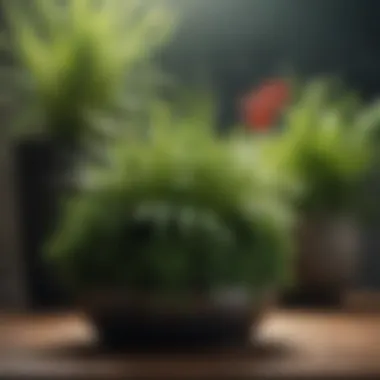
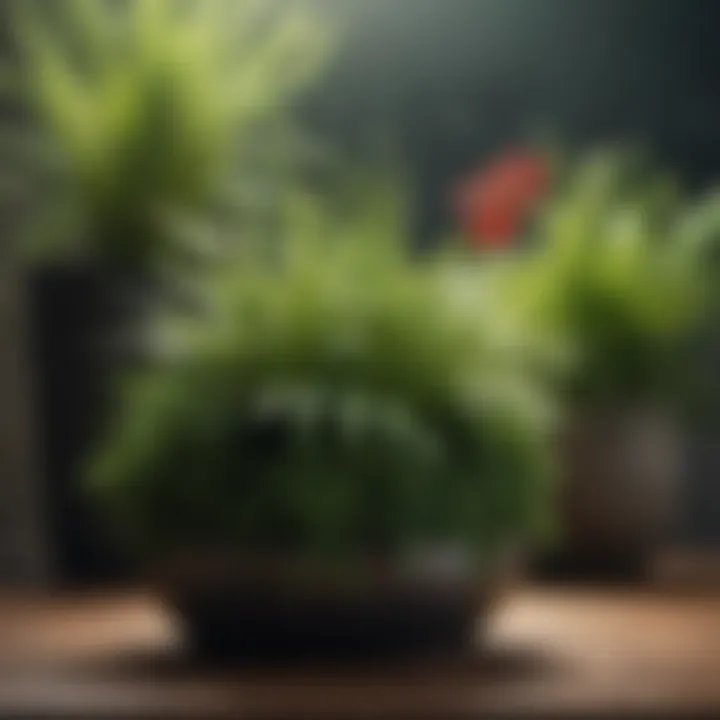
“The right container can be the difference between a serene escape and an overlooked corner of your garden.”
- Focal Points: Strategically placed containers can serve as focal points, guiding the observer’s eye throughout the garden space. Adding large, eye-catching fixtures can break monotonous landscape lines and introduce excitement.
In sum, containers are not merely vessels for holding water or soil. They are integral to the health of the aquatic ecosystem and serve as crucial aesthetic elements that enhance the overall beauty of water gardens. Understanding their significance can elevate a simple garden to an intricate and balanced paradise.
Material Choices for Containers
When setting up a water garden, the choice of container material is crucial. The material you select significantly impacts the aesthetic, drainage capabilities, and the health of the aquatic ecosystem. Each type comes with its own set of benefits and drawbacks; knowing these can help you make an informed decision to create a thriving environment for plants and wildlife.
Plastic
Benefits
Plastic containers have become a favorite among many water garden enthusiasts mainly due to their lightweight nature and affordability. Being easy to move around, they grant flexibility in design and placement. These containers are available in various sizes and shapes, accommodating different types of aquatic plants. One unique aspect of plastic is its resistance to cracking and shattering—an advantage especially in colder climates where changes in temperature can be severe. In addition, they usually come with built-in drainage holes, which help in preventing water stagnation.
Drawbacks
On the downside, plastic isn’t always the most aesthetically pleasing option. While there are decorative choices, many tend to look quite utilitarian. Additionally, plastic can degrade over time, especially when exposed to UV rays from the sun, which might lead to a shorter lifespan of the containers. Another point to note is that some types of plastic can leach harmful chemicals into the water, affecting the health of aquatic life.
Ceramic
Benefits
Ceramic containers can elevate the visual appeal of your water garden. Their intricate designs and colors add an artistic touch that many gardeners appreciate. One of the strong points of ceramic is its excellent insulation properties, which help maintain stable water temperatures. Ceramic is also durable and, unlike some other materials, doesn’t degrade from sun exposure, allowing for long-lasting beauty in your garden.
Drawbacks
However, these benefits come with a price. Ceramic containers can be quite heavy, making them less mobile than plastic options. They are also prone to cracking if not handled with care, particularly in colder climates. This fragility necessitates careful consideration of placement to avoid damage. Furthermore, ceramic containers typically have a higher price point, which might not align with every budget.
Fiberglass
Benefits
Fiberglass presents a happy medium between plastic and stone. Light yet durable, it can easily replicate the look of stone or ceramic without the associated weight. It’s resistant to weather effects, thereby prolonging its lifespan, making it an excellent investment. The unique aspect of fiberglass is its ability to be molded into various shapes and designs, allowing for custom solutions that fit perfectly into your garden’s theme.
Drawbacks
One downside, though, is that fiberglass can sometimes be less aesthetically pleasing than natural materials. Synthetic finishes may not blend as seamlessly with garden environments as stone or ceramic would. Another drawback is that depending on the manufacturing process, certain fiberglass containers can release harmful chemicals into the water, albeit infrequently.
Stone and Concrete
Benefits
Stone and concrete containers are known for their rugged appearance and durability. They can withstand various weather conditions, making them suitable for outdoor use year-round. These materials often lend a natural aesthetic that fits seamlessly into most garden styles. A noteworthy feature is their weight, which helps prevent containers from being easily tipped or moved around by wind.
Drawbacks
On the flip side, stone and concrete containers can be quite heavy and less portable. If you want to alter the layout or design of your garden frequently, this might be a hindrance. Additionally, they can accumulate algae and require regular cleaning to maintain visual appeal. Concrete, in particular, can leach lime into the water, which may elevate pH levels and affect aquatic life if not managed properly.
In the end, the material you choose for your water garden containers will significantly affect the overall aesthetics, functionality, and health of the aquatic ecosystem you aim to create. Consider these factors thoroughly as you explore your options.
Choosing the Right Size
Selecting the right size for your containers is crucial, almost like a blueprint when designing a water garden. A well-thought-out choice can significantly enhance the growth of plants and ensure that the ecosystem within your garden flourishes. Containers come in various shapes and sizes, each serving a unique function. Skip the guesswork and aim for a methodical approach, as the wrong size can lead to stunted growth or even the demise of your aquatic plants.
Considerations for Plant Growth
When it comes down to it, the size of your container directly influences plant growth. If you choose a container that's too small, roots may become cramped, restricting their ability to absorb nutrients and water effectively. This can stunt the plants’ development and hinder their overall health. Conversely, excessively large containers might encourage overwatering or root rot, creating a swampy environment that few plants will thrive in. In terms of specific factors:
- Depth: Different plants have varying needs for root space. For instance, submerged plants generally require deeper containers compared to marginal plants that may thrive in shallower depths.
- Diameter: Wider containers provide more surface area for plant diversity. Grouping several small plants can create a rich tapestry of colors and textures, while a single large plant makes a bold statement.
- Volume of Water: Larger containers can stabilize water temperatures and maintain a healthier aquatic environment. This means less fluctuation between hot days and cold nights, providing a more consistent habitat for your plants.
"The right size is not just a number; it's the foundation of a thriving ecosystem. Think before you plant."
Space Availability
Understanding your available space lays the groundwork for deciding on container size. The placement can dictate what size is feasible without overpowering the rest of your garden space. Tight corners may necessitate smaller, more compact containers, while expansive areas can accommodate larger setups. Key aspects to consider include:
- Garden Layout: If your yard is dense with foliage, smaller containers can fit into tight spots while still allowing for visual interest and interaction with nearby plants.
- Design Elements: If balancing aesthetics is a priority, integrating varied sizes can create depth and intrigue. Remember the principle of scale—if everything is the same size, you risk boredom.
- Physical Accessibility: Think about how often you will tend to the garden. Larger containers may be easier to manage from a distance but hard to clean up close. Smaller containers can be lifted easier but may get heavy when filled.
The choice of size isn't merely a functional decision; it's also a creative one. When you account for plant needs and your site's specific characteristics, you'll create a water garden that's both beautiful and sustainable.
Design Options for Containers
When it comes to creating a water garden, the design of the containers used for the aquatic plants is pivotal. Choosing the right design isn't just about aesthetics; it can impact plant health, maintenance ease, and even the overall arrangement of your garden space. Different designs lend themselves to various functionalities, making it essential to explore the options available.
Round vs. Square Containers
The choice between round and square containers can feel like picking between apples and oranges, each with unique virtues. Round containers typically provide a more natural vibe and can help plants in drawing moisture evenly around their roots. The gentle curves can mimic the shapes found in nature, making it ideal for a water garden aiming for a tranquil feel.
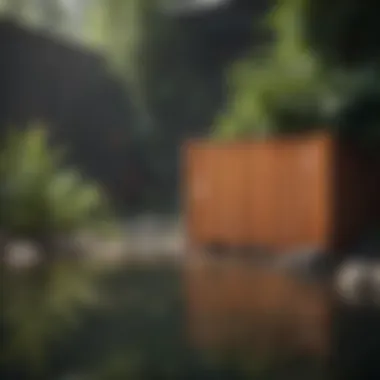
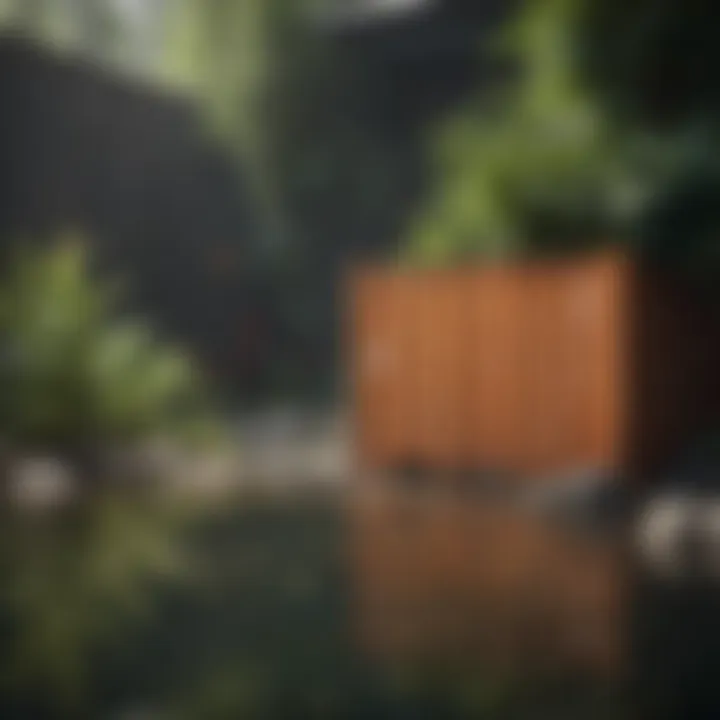
On the flip side, square containers are often easier to align and arrange, especially if you seek a more formal or structured design. They can be lined up neatly to create visual symmetry, which might appeal to those who enjoy clean lines and a more organized look. Moreover, square containers can fit snugly in corners or tighter spaces, optimizing your garden layout. To put it simply:
- Round Containers: Natural look, even moisture distribution, ideal for blending into a garden.
- Square Containers: Structured appearance, maximizes space, easy to arrange.
In some cases, mixing these shapes can yield a visually striking assortment that still plays well with garden planning, allowing for a degree of creativity.
Stackable Container Designs
Another noteworthy option is stackable container designs. Not only do they maximize vertical space, but they also introduce a unique dimension to your garden. Imagine an edible garden herb stack, where each layer brings a burst of greenery and life. These designs work wonders particularly in smaller spaces, allowing you to create a multi-level garden that feels both dynamic and full.
Beyond the functionality, stackable containers can be a chance to showcase your creativity. You can experiment with varied sizes and colors to craft an eye-catching display. For instance, a stack of brightly colored containers can contrast beautifully with rich green aquatic plants, creating striking visual appeal. Additionally, stackable options often offer drainage features that can be vital for maintaining healthy water quality.
Considerations when opting for this design include:
- Stability: Make sure that the containers are designed for stacking without being wobbly.
- Access for Care: Ensure that you can easily reach every layer for maintenance.
- Water Management: Check if each tier has proper water drainage to prevent sogginess.
"The right container design can elevate a water garden from just functional to truly artistic, while making maintenance easier."
Use of Color and Texture
Color and texture play significant roles in container designs, providing endless possibilities for creativity. A vibrant splash of color can transform a mundane garden into a striking landscape. Bright colors like red or yellow can create a lively atmosphere, while earthy tones can blend seamlessly with natural surroundings.
Texturally, options range from smooth ceramic to rugged stone, with each bringing its own flair. Smooth surfaces might shine in sunlight, while textured materials offer a gritty feel, adding to a rustic charm. It’s essential to think about how these elements work together.
For example, if your garden features lush green water lilies, consider containers in contrasting colors to highlight their beauty. You might also want to opt for containers that have intricate designs, offering a visual feast even before the plants grow and flourish. In essence:
- Color: Use it to evoke moods or draw attention.
- Texture: Choose it for tactile diversity and uniqueness in your design.
Placement Considerations
The placement of water garden containers plays a pivotal role in determining their overall success and longevity. Selecting the right spot not only enhances the aesthetic appeal but also ensures an optimal environment for the aquatic plants and animals thriving within. When deciding where to position your containers, several key considerations emerge that can significantly affect both the enjoyment and functionality of your water garden.
Sunlight Requirements
When it comes to aquatic plants, their light requirement can vary significantly. Some thrive in bright conditions, while others do better in partial shade.
- Full Sun: Plants like water lilies do best when they receive an ample amount of sunlight, ideally around 6 to 8 hours daily. This helps them grow robustly and bloom.
- Partial Shade: Varieties such as certain submerged plants prefer a little break from the harsh midday sun. Too much heat can lead to excessive algae growth, so finding that sweet spot can make a world of difference.
"Choosing the right sunlight exposure is critical to maintaining a healthy water garden."
Accessibility and Viewing
Accessibility isn't just about getting to your containers; it’s also about how well you can enjoy them. Placing your water garden in a spot that’s easy to reach enables routine care:
- Regular Maintenance: You want to routinely check water levels, trim dead leaves, and ensure the filtration systems are working. If a container is tucked away behind a bush, these chores can turn into a daunting task.
- Optimal Viewing Angles: Imagine the serene feeling as you unwind near your water feature, sipping a cool drink while listening to the gentle sound of water. Positioning your containers where they catch your eye from common seating areas adds to the pleasure of having a water garden.
Wind and Weather Factors
Weather conditions can make or break your water garden's integrity. Wind can lead to increased evaporation or even topple lighter containers. Thus, consider the following:
- Natural Windbreaks: Utilize hedges or fences as wind barriers. This can help reduce turbulence that can cause waves and splashes, which are often unpleasant and can deplete your water levels quickly.
- Seasonal Changes: Observing local weather patterns helps in understanding the best placement. If you live in an area prone to heavy rainfall, positioning containers in such a way that they’re not exposed to direct run-off from roofs can prevent flooding of your plants.
When done right, thoughtful placement elevates your water garden’s appeal and functionality. Connecting with the environment around you ensures a harmonious relationship between your gardening ambitions and the natural world.
Plant Selection for Water Gardens
Choosing the right plants for water gardens is not just about aesthetics; it’s crucial for establishing a balanced ecosystem. The plants you select play a significant role in water quality, providing oxygen to the water, and offering habitats for various aquatic creatures. Furthermore, these plants can enhance the beauty of your water garden, serving as both focal points and subtle touches that integrate with your design. In this section, we will explore different categories of aquatic plants, their unique characteristics, and their roles in maintaining a vibrant and healthy water garden.
Aquatic Plants Categories
Floating Plants
Floating plants are a striking feature within water gardens, easily recognized for their ability to drift on the water's surface. They don’t anchor themselves in soil; instead, they rely on their buoyant nature. One of the most notable characteristics of floating plants is their broad leaves, which can provide shade. This shading helps regulate water temperature and offers shelter to fish and other aquatic life.
These plants are beneficial because they can absorb excess nutrients from the water, reducing algae growth—something that many gardeners dread. Additionally, their roots hang in the water and often trap particles, improving water clarity. However, one downside to floating plants can be their rapid growth rate; they can cover the surface entirely if not managed, potentially hindering light from reaching submerged plants below. Popular choices include Water Hyacinth and Duckweed, both celebrated for their functionality and visual appeal.
Submerged Plants
Diving deeper into the aquatic ecosystem, submerged plants thrive entirely underwater. They are essential for oxygenating the water, making them a crucial element in keeping water gardens healthy. A standout quality of submerged plants is their finely divided foliage, which increases surface area and enhances oxygen release into the surrounding water.
Submerged plants also provide valuable habitat for various aquatic organisms. These plants can be a haven for fish fry and invertebrates, giving them a safe space to grow away from predators. However, it's important to note that they do not require the same amounts of light as surface plants, which can sometimes lead to issues if the plant becomes too dense, as it may choke out other plants. Popular options in this category include Eelgrass and Hornwort, which excel at filtration and habitat provision.
Marginal Plants
Marginal plants occupy the edges of the water garden, growing in the transitional zone between water and land. Their unique feature includes a robust root system that often stabilizes soil, preventing erosion and providing support for the surrounding ecosystems. What makes marginal plants particularly appealing is their adaptability to varying water levels, which allows for flexibility in design and arrangement.
These plants are known for adding vertical height and color contrast to water gardens. They can produce stunning flowers and foliage that can significantly enhance overall visual appeal. However, they may require more maintenance compared to other plant categories, as some can grow quite large and may need regular pruning to maintain their shape. Excellent choices include Cattails and Marsh Marigold, admired for both their practical benefits and ornamental beauty.
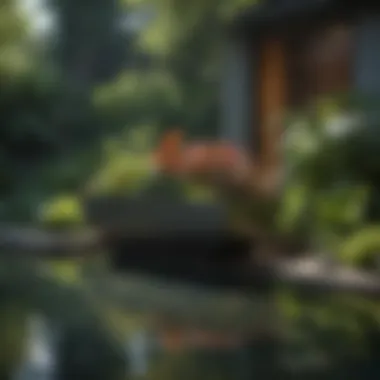
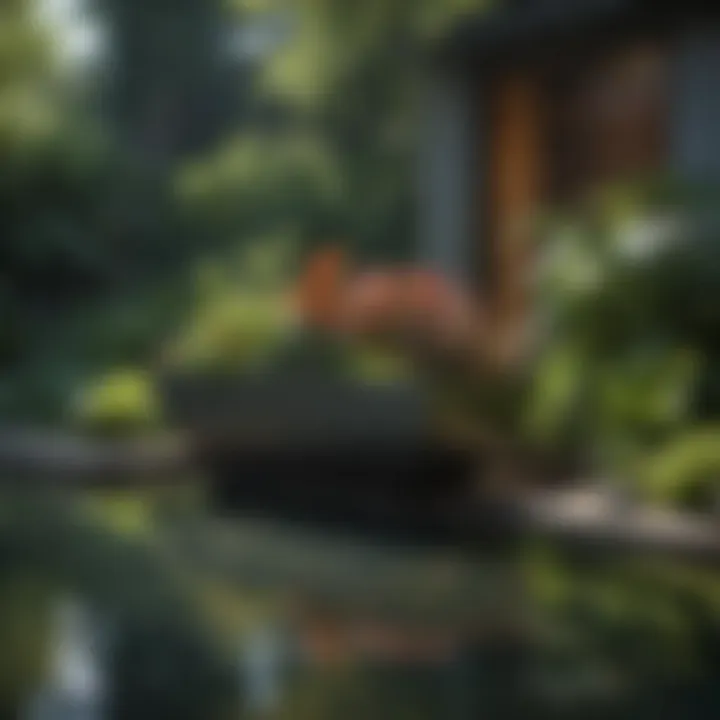
Compatibility with Container Size
Selecting the right container size is a key consideration when it comes to planting. Each aquatic plant category has specific space requirements that need to be addressed throughout the selection process. A container that’s too small might restrict root growth, leading to unhealthy plants. On the flip side, a container that’s too large could present challenges in managing water quality and nutrients.
General Guidelines for Compatibility:
- Floating plants: Generally require less depth but need a wide surface area to thrive, fostering good spread and coverage.
- Submerged plants: Need containers that provide depth to accommodate their root systems and promote successful anchoring.
- Marginal plants: Benefit from wider pots to allow for expansive root systems while managing growth above the waterline.
Keeping these plant selection and compatibility factors in mind enriches the overall garden experience, ultimately enhancing both beauty and ecosystem functionality.
Water Quality Management
Water management is a cornerstone in maintaining healthy water gardens. With a proper approach, not only does the aesthetics improve, but it's crucial for the livelihood of your aquatic plants and any wildlife that may call your water garden home. The components of water quality directly influence the ecosystem – from the type of algae to the health of fish or amphibians. Effective water quality management ensures a balanced environment by safeguarding against pollutants that can wreak havoc on the delicate balance within these micro-ecosystems.
A robust water quality management system can prevent issues related to overgrowth of algae, which can use up precious oxygen in the water, thus harming any plant or animal life. When the delicate interplay between water chemistry, temperature, and biological activity is well-regulated, you ultimately foster a flourishing aquatic lifestyle with beautiful water features.
Importance of Water Quality
The clarity and chemistry of water matter significantly when cultivating a water garden. First off, beneficial microbes thrive in clean water; they play a vital role in breaking down organic matter, making nutrients available for plant roots. Poor water quality can lead to murky conditions where light penetration is compromised. This impedes aquatic growth because plants rely on sunlight for photosynthesis.
Additionally, maintaining optimal pH levels, usually around 6.5 to 7.5, is paramount. Deviations can stress your plants and fish, leading to a host of problems, from stunted growth to increased vulnerability to disease.
Key Benefits of Vigilant Water Quality Management:
- Enhances biodiversity and promotes a balanced ecosystem
- Minimizes harmful algal blooms
- Promotes clearer water, which is visually appealing
- Protects the health of aquatic life
- Reduces the need for chemical interventions, leading to sustainable gardening practices
"Healthy water is the backbone of a well-balanced ecology. Without it, a water garden can easily turn into a pond of troubles."
Filtration and Aeration Methods
When it comes to keeping your water pristine, filtration and aeration techniques come into play effectively. Filtration works by physically removing debris and contaminants from the water. Use mechanical filters that trap particles while also considering biological filtration, which uses beneficial bacteria to break down harmful wastes. The right combination of these methods can greatly reduce the burden of manual cleaning.
Aeration plays a different yet equally important role. By bringing air into the water, aeration helps maintain oxygen levels, which is crucial for fish and beneficial microbes. Here are popular methods you can employ:
- Surface Aerators: These devices agitate the surface of the water to increase oxygen exchange with the air.
- Diffusers: Submerged systems that blow air into the water column, circulating it and enhancing oxygen levels downwards.
- Waterfalls and Fountains: A natural method that beautifies while providing aeration through water movement.
In summary, a meticulous approach to water quality management not only transforms your water garden into a vibrant escape but also sustains its health through filtration and aeration. The effort put into these processes pays dividends in terms of both enjoyment and long-term sustainability.
Maintenance of Water Containers
Caring for water containers is not only a necessity but a fundamental aspect of maintaining a pristine aquatic environment. Just like any garden element, if the containers aren't properly looked after, the entire ecosystem can be thrown into disarray, leading to potential problems like algae bloom and plant decay. Understanding the importance of regular maintenance can keep your water feature vibrant and thriving while safeguarding the delicate balance of nature within your garden.
Routine Cleaning Practices
Keeping your water containers clean goes beyond aesthetics; it plays a critical role in supporting the health of your aquatic plants and the overall ecosystem. Over time, debris such as fallen leaves, dirt, and organic matter can accumulate, potentially disrupting water quality. Here's how to maintain cleanliness:
- Remove Debris: Regularly check your containers for any visible debris. Use a net or fine mesh to scoop out leaves and other unwanted materials.
- Scrub the Walls: Algae can become a stubborn issue, making it necessary to scrub down the walls of the container with a soft brush. Be gentle to avoid scratching surfaces, especially if your container is made of materials like ceramic or fiberglass.
- Replace Water: Change the water periodically to refresh the body of water. This can help prevent stagnation and reduce bacterial buildup.
- Check for Cracks: Inspect your containers for any cracks or wear. Addressing these issues promptly can save you from larger problems down the line.
Remember, a little elbow grease goes a long way when it comes to the health of your water gardens.
Winterizing Containers
As the temperatures drop, preparing your water containers for winter is crucial for ensuring their longevity and maintaining a healthy aquatic environment for the next growing season. Winterizing your containers involves several key steps:
- Store Indoors: If possible, move smaller containers indoors to prevent ice damage. Cold weather can cause materials like plastic or ceramic to crack if left outside.
- Drain Water: Empty larger containers to avoid the freezing and expansion of water, which can lead to structural damage.
- Clean Thoroughly: Before storing, ensure that your containers are cleaned and free from algae and plant remnants. This reduces the risk of pests and diseases when spring arrives.
- Wrap or Insulate: Consider wrapping your containers with insulating materials to protect them from cold temperatures. Materials like bubble wrap can help prevent freezing.
Tip: Always double-check that no aquatic plants are left in the containers before winter! They can suffer from cold and die off, might lead to an unwanted decay next season.
Maintaining your water containers is an ongoing commitment, but it’s also an opportunity to engage with and enrich your gardening experience. By adopting these practices, you ensure your water gardens are prepared for the changing seasons and ready to provide you with the beauty and serenity they are known for.
Environmental Considerations
Creating a water garden goes beyond simple aesthetics; it serves as an intricate part of the local ecosystem. Containers used in these gardens don’t just hold plants and water; they can have profound implications on natural habitats. At the heart of this discussion is the need to recognize and appreciate the delicate connections between our gardens and the local environment. This section delves into two critical aspects: the impact on local ecosystems and sustainable water practices.
Impact on Local Ecosystem
Using containers in water gardens can positively influence local ecosystems if done thoughtfully. When selecting the appropriate types of containers, there's often an overlooked note regarding drainage and permeability. Not all pots are designed equal, and some can create waterlogged conditions that may hinder growth, not just for your plants, but also for the surrounding soil ecosystem.
If you use plastic containers heavily treated with chemicals, you might inadvertently introduce toxins that could permeate the ground water. This is particularly important if your garden is near water sources frequented by wildlife. The ideal choice? Look for materials free from harmful chemicals, such as natural clay or ceramics.
Plants grown in these containers act as mini biofilters, purifying the water and providing habitat for various organisms like dragonflies and frogs. When these creatures thrive, they help control pests and pollinate nearby flora, thus promoting biodiversity.
"Integrating water gardens into your landscape not only enhances your property’s appeal but also fosters a habitat that promotes ecological balance."
Sustainable Water Practices
Sustainability should be a central theme in nurturing your water garden. One of the foremost practices is opting for rainwater collection systems to fill your containers rather than relying on municipal sources. This not only reduces water waste but also supports the local water cycle.
Regularly monitoring water levels can help maintain a suitable environment for your aquatic plants and creatures. Here are some tips:
- Implement a Filtration System: Whether it’s mechanical, biological, or chemical, each plays a role in keeping the water clean.
- Plant Native Species: They are already adapted to local conditions, require less maintenance, and support indigenous wildlife.
- Limit Chemical Use: If pests start posing a problem, try to opt for organic methods or introduce beneficial insects rather than chemical solutions.
Moreover, understanding the interconnectedness of water gardens with the local ecosystem is essential. Organic waste from plants can decompose and enrich the soil, thus creating a sustainable gardening cycle. When you take these factors into account, you foster not just a water garden, but a thriving ecological haven.
By choosing the right materials, managing water wisely, and being mindful of local wildlife, water gardens can flourish in harmony with nature. Thus, conscientious gardening choices significantly reflect larger environmental responsibilities.







